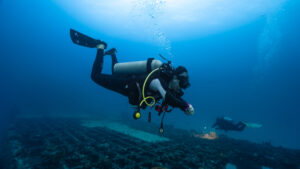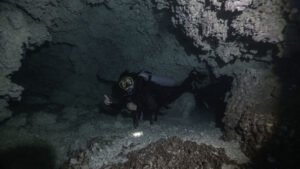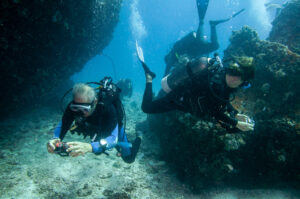What is Laryngospasm?
Laryngospasm is a sudden, involuntary contraction of the vocal cords that can temporarily block airflow to the lungs. In the context of scuba diving, this condition is particularly hazardous because it can occur unexpectedly and lead to life-threatening situations underwater. Understanding laryngospasm is crucial for divers, as it directly impacts their safety and ability to respond effectively to underwater emergencies.
Physiology of Laryngospasm
Laryngospasm involves the abrupt tightening of the muscles surrounding the larynx, which includes the vocal cords. This muscular action results in the closure of the airway, preventing air from passing into the lungs. The larynx, located at the top of the trachea, plays a vital role in breathing, swallowing, and speech. When the vocal cords contract uncontrollably, they can completely obstruct the airway, causing a person to struggle for breath.
This reflexive response can be triggered by various stimuli, including irritants like water, dust, or strong fumes. In non-diving situations, laryngospasm often occurs as a protective mechanism, preventing foreign substances from entering the lower respiratory tract. However, underwater, the reflex can be initiated by factors unique to the diving environment, creating a potentially dangerous scenario.
The physiological mechanism behind laryngospasm involves complex neural pathways. The vagus nerve, which controls the laryngeal muscles, plays a central role in this reflex. When triggered, signals from the vagus nerve cause the muscles to contract. This contraction can vary in intensity, leading to partial or complete closure of the airway. Understanding these physiological processes helps in identifying and managing laryngospasm, especially in the challenging conditions encountered during scuba diving.
Causes of Laryngospasm in Scuba Diving
Laryngospasm in scuba diving can be triggered by several factors unique to the underwater environment. One of the most common triggers is the inhalation of cold water, which can occur if a diver’s regulator malfunctions or if they accidentally remove their mouthpiece. The sudden rush of cold water can irritate the vocal cords, causing them to contract and block the airway.
Another significant cause is the accidental inhalation of water. This can happen if a diver panics and inhales sharply, allowing water to enter the mouth and reach the larynx. The body’s natural response to this is to protect the lungs by closing off the airway, resulting in laryngospasm. Equipment issues, such as poorly fitting masks or malfunctioning regulators, can increase the risk of water entering the airway.
Psychological factors also play a crucial role in the occurrence of laryngospasm. Stress and panic can exacerbate the likelihood of experiencing this condition. Divers who are not adequately trained to handle unexpected underwater situations may react with fear, leading to rapid, shallow breathing or gasping, which can trigger laryngospasm. Proper training and mental preparedness are essential to minimize these psychological triggers.
Environmental factors, such as cold water temperatures and exposure to irritants in the water, can further contribute to the risk. Cold water can stimulate the vagus nerve, which controls the laryngeal muscles, while pollutants and other irritants can inflame the airway, making it more susceptible to spasms. Understanding these causes is vital for implementing preventive measures and ensuring the safety of divers.
Symptoms and Diagnosis
Recognizing the symptoms of laryngospasm during a dive is crucial for timely intervention and safety. The most apparent symptom is the sudden inability to breathe, often accompanied by a feeling of tightness or constriction in the throat. Divers may also experience coughing, a sensation of choking, and difficulty speaking. These symptoms can cause panic, exacerbating the situation and making it harder to regain control of breathing.
In severe cases, laryngospasm can lead to hypoxia, where the body’s oxygen levels drop dangerously low. This can result in cyanosis, a bluish discoloration of the lips and skin, indicating a critical lack of oxygen. If the spasm persists and is not relieved, it can cause unconsciousness, posing a severe threat to the diver’s life. Immediate recognition of these symptoms is essential for taking swift and appropriate action.
Diagnosing laryngospasm involves assessing the symptoms and the context in which they occurred. After an incident, a medical evaluation is necessary to rule out other potential causes of airway obstruction, such as allergic reactions or mechanical blockages. A thorough examination by a healthcare professional, often including laryngoscopy, can help confirm the diagnosis and determine the extent of the spasm and any resulting damage to the airway.
Differentiating between mild and severe laryngospasm is important for appropriate treatment. Mild cases might resolve on their own or with simple interventions, while severe cases require more intensive medical care. Understanding the diagnostic process and recognizing the symptoms early can make a significant difference in outcomes for divers who experience laryngospasm underwater.
Preventive Measures
Preventing laryngospasm is a critical aspect of scuba diving safety. One of the primary preventive measures is thorough training that includes understanding the risks and proper responses to potential triggers. Divers should be trained to avoid panic and maintain calm, controlled breathing even in stressful situations. This mental preparation is crucial for reducing the likelihood of laryngospasm.
Equipment checks and maintenance play a vital role in prevention. Ensuring that all diving gear, particularly regulators and masks, are in good working condition and properly fitted can minimize the risk of water entering the airway. Regular inspection and servicing of equipment help prevent malfunctions that could lead to accidental water inhalation and subsequent laryngospasm.
Diving conditions should also be carefully considered to prevent laryngospasm. Avoiding dives in extremely cold water or highly polluted areas can reduce the risk of triggering this reflex. If diving in cold water is necessary, using appropriate thermal protection, such as wetsuits or drysuits, can help maintain body temperature and reduce the likelihood of cold water stimulating the vagus nerve.
Mental preparedness techniques, such as visualization and controlled breathing exercises, can help divers remain calm and focused during their dives. By practicing these techniques regularly, divers can build their resilience to stress and reduce the likelihood of panic-induced laryngospasm. Additionally, divers should be aware of their physical condition and avoid diving if they have respiratory infections or other conditions that could increase the risk of airway irritation.
Management and Treatment
Managing laryngospasm underwater requires immediate and effective action to ensure the diver’s safety. The first step is to signal for help if possible, using the established underwater communication methods. Divers should remain as calm as possible and attempt to slow their breathing, which can help relax the vocal cords and alleviate the spasm. In many cases, the spasm will resolve within a minute or two if the diver can stay calm and avoid further irritation to the airway.
Once on the surface, medical evaluation is essential to ensure there are no lingering effects or underlying conditions that need treatment. Oxygen therapy may be administered to help restore normal breathing and oxygen levels. In severe cases, where the airway remains obstructed, emergency medical interventions, such as intubation, may be necessary to secure the airway and ensure adequate ventilation.
Post-incident follow-up is important for addressing any potential complications and for preventing future occurrences. Divers who have experienced laryngospasm should consult with a healthcare professional, preferably one with experience in diving medicine. They may undergo further tests to assess their airway health and receive guidance on managing any underlying conditions that could predispose them to laryngospasm.
Long-term health considerations include monitoring for recurrent episodes and making lifestyle adjustments as needed. Divers may need to take additional precautions or undergo specialized training to continue diving safely. Understanding the importance of medical follow-up and adhering to recommended precautions can help divers manage their condition and reduce the risk of future incidents.
Implications for Diver Training and Safety Protocols
Incorporating the risks and management of laryngospasm into diver training programs is essential for enhancing overall safety. Training should include comprehensive information on the causes, symptoms, and preventive measures associated with laryngospasm. By equipping divers with this knowledge, training programs can help them recognize and respond effectively to this condition.
Safety protocols should be updated to address the specific challenges posed by laryngospasm. This includes ensuring that emergency response plans are in place and that all divers are familiar with them. Regular safety drills can help reinforce these protocols and ensure that divers are prepared to handle an incident of laryngospasm. Additionally, dive leaders and instructors should be trained to recognize the signs of laryngospasm and provide immediate assistance.
Continuous learning and awareness are vital for both recreational and professional divers. Staying informed about the latest research and developments in diving medicine can help divers and instructors remain vigilant about potential risks. Diving organizations should prioritize ongoing education and provide resources to support divers in maintaining their knowledge and skills.
By integrating laryngospasm awareness into training and safety protocols, the diving community can enhance its preparedness and reduce the incidence of this potentially life-threatening condition. Ensuring that all divers are well-informed and equipped to handle laryngospasm is a crucial step in promoting safety and preventing accidents.
Key Takeaways
Laryngospasm is a sudden and involuntary contraction of the vocal cords that can pose serious risks to scuba divers by obstructing airflow to the lungs. Understanding the physiology, causes, symptoms, and preventive measures is essential for maintaining diver safety. Effective management involves immediate response strategies and medical evaluation to ensure long-term health. Integrating laryngospasm awareness into diver training and safety protocols enhances preparedness and reduces the risk of incidents, promoting a safer diving environment.

















